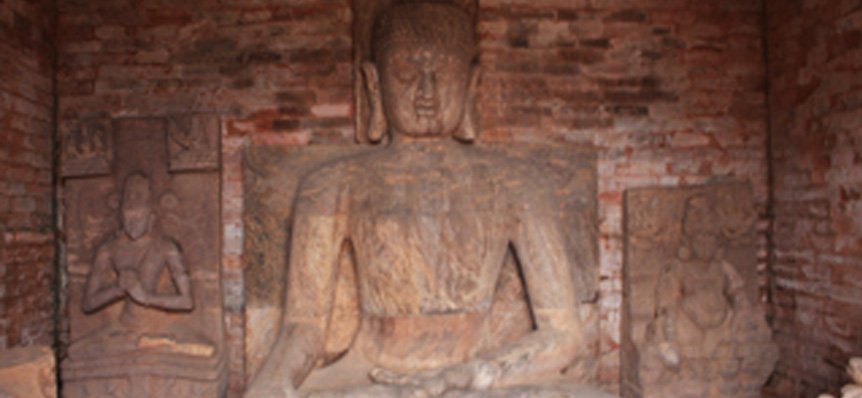
RATNAGIRI, UDAYAGIRI AND LALITGIRI
- The Buddhist Monasteries, Stupas and Chaityagrihas at Udayagiri, Ratnagiri and Lalitgiri are one of its kind," said T. Donaldson, eminent historian of USA.
- According to some researchers, the Buddhist sites at Ratnagiri, Udayagiri and Lalitgiri have two wings — archaeology and art history — hardly found elsewhere.
- Rathnasiri Rathnayaka, lecturer of Buddhist and Pali University of Sri Lanka, said: "I have come across many Buddhist sites in the world, but I find these sites quite exceptional, especially for their beautiful architecture.
- The beautiful hills and rice-growing lands are home to remarkable Buddhist remains of the Vajrayana sect, set in an idyllic landscape surrounded by green fields. The excavations at the three sites have revealed Buddhist stupas, monasteries, sculptures and Buddha images.
- Along with Udayagiri and Ratnagiri, Lalitgiri constitutes the Diamond Triangle. The three hills preserve the ruins of the Buddhist complex that once flourished in the state of Orissa. Lalitgiri, the earliest Buddhist sandstone hills, dates back to 1st century AD.
PUSPAGIRI
- There is a vast significance of Buddhism in Orissa. The History of Buddhism in Orissa is very rich. It can be very well traced from the existence of beautiful Stupas, Vihars and Chaityas, which were revealed during the course of excavation in Ratnagiri, Udaygiri, Lalitgiri, Langudi and other nearby places in the district of Jajpur.
- Pushpagiri University or Puspagiri Mahavihara (2nd century BC to 10th century AD), a prominent Buddhist seat of higher learning in ancient India, blossomed until the 11th century in the country. One can find its ruins atop the Langudi hills.
- Pushpagiri is considered parallel to the Nalanda, Vikramshila and Takshila universities. Chinese traveler Xuanzang (Huien Tsang), who visited the region in 639 CE, mentioned about Pushpagiri University as Puspagiri Mahavihara in his famous travelogues. Moreover, there is also mention of Puspagiri Mahavihara in medieval Tibetan texts.
RATNAGIRI
Ratnagiri, as it depicts in English 'Jewel Hill', on the bank of River Keluo, has been the best finds in the field of typical engraved Buddhist monuments and ancient sculptures. On excavation, The findings include three monasteries (two quadrangular), eight temples and a number of stupas believed to be dating from the seventh century. The largest monastery (i.e. the monastery No. 1) is 55 sqm with a surrounding veranda with 60 pillars built around a courtyard. The entry to this marvelous courtyard is through a carved gateway. At one end, the shrine has a khandolite Buddha image and remnants of about 24 cells for monks which were built of brick but had stone door frames. One can have Look at the intricate carving on the doorway of the back porch wall: a dancer stamping her feet; a royal lady with her arm around a maid; a woman meditating. Four galleries display fine sculptural figures dating from the ninth to the 10th centuries, terracotta and ivory objects, inscribed copper plates and miniature bronzes produced by the lost-wax process.
UDAYAGIRI
Udayagiri, "Sunrise Hill", is home to another large Buddhist complex in Odisha. Two monasteries have been unearthed here at Udayagiri. The Buddhist complexes at Udayagiri are composed of major stupas and monasteries (viharas), similar to Ratnagiri. As per epigraphical artifacts found here, the historical names of these two monastires (Vihars) were "Madhavapura Mahavihara" and "Simhaprastha Mahavihara". The Udayagiri sites have been dated back to 1st-13th centuries AD. There is a beautiful stepped stone well at the entrance point of Monastry No. 1, which is an indicator that how the people at that point of time used to extract water from the well by use of steps unlike the present day method of pulling water by use of a container tied to a rope.
LALITGIRI
- The earliest Buddhist Complex dating back to the 1st century AD. It is Well connected by excellent roads from Cuttack and Bhubaneswar. The excavations here have brought to light significant archaeological material that upholds Lalitgiri as a great centre of Buddhist attraction.
- The majestic ruins of the huge brick monastery, the remains of the chaitya hall, a number of votive stupas and a renovated stone stupa at the peak of a small rough sandstone hill are the dominant structures in the area and are befitting to the nature's beauty around.
- The museum at Lalitgiri displays a large number of Mahayana sculptures consisting of colossal Buddha figures, huge Boddhisattva statues, statues of Tara, Jambhala and others. There are short inscriptions on most of these sculptures.
- A stone platform with inscriptions dates this site closer to the second century although Kushana Brahmi inscriptions on an underlying brick stupa suggest Buddhist occupation around the first century BC.
- Three caskets were also found, two of which contained stone, silver and gold caskets with preserved relics inside. The discovery of caskets containing sacred relics, probably of Gautam Budha himself, further enhances the sacredness of the stupa as well as of Lalitgiri for Buddhists around the world.
LANGUDI
- The excavations at Langudi hills have brought to light a treasure trove of architecturally and sculpturally rich Buddhist remains. There are many cut votive Stupas which attracts the attention. Two unique images of Budha including the Buddha in Samadhi-mudra, Sculpture of Goddess Tara, the harmonic umbrella, the Cylin dome etc. have revealed a new chapter in the Buddhist tourist destinations in the state of Odisha.
- The most remarkable and prize discovery of this palce are the two inscribed images of emperor Ashoka, one single and the other with his two queens.
DHAULI
Dhauli hills are located on the banks of the river Daya, about 8 km south of Bhubaneswar capital city of the state of Odisha, in the eastern part of peninsular India. There are major rock Edicts of Ashoka engraved on a mass of rock, by the side of the road leading to the summit of the hill. The area adjacent to Dhauli hill is presumed to be the area where the famous Kalinga War was fought.


